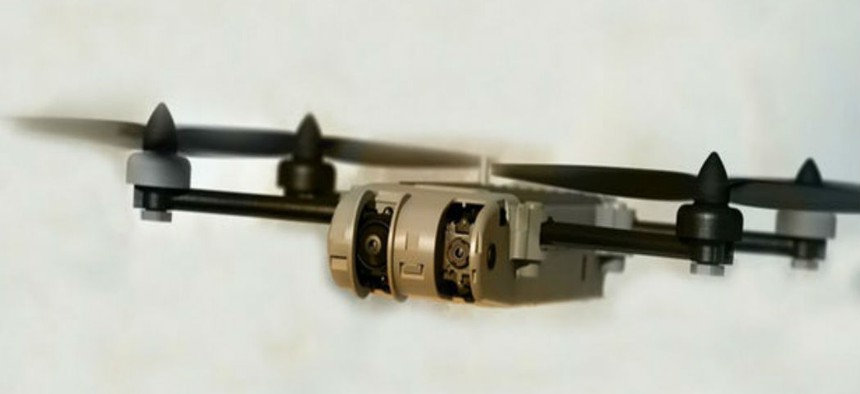Soldiers will soon have rugged small personal drones
A new drone is the size of a smartphone and increases situational awareness with infrared sensors and image processing.
AeroVironment’s newly released unmanned aerial vehicle (UAV) system, equipped the latest infrared imaging and processing technology, consists of a rugged control tablet and two drones small enough to sit in a soldier’s palm.
This latest nano unmanned vehicle (NAV), called the Snipe, is a 140-gram autonomous quadcopter that can reach speeds of up to 22mph for a distance of almost a mile, and endure winds up to 20 mph, according to AeroVironment statements.
A quadcopter or quadrotor is a type of rotorcraft that has four vertically-oriented propellers, branching out from the central motor at 90-degree angles. The front and back propellers typically spin clockwise, while the ones on either side spin counterclockwise, and each of the four propeller motors can operate independently. They are controlled by algorithms that change the accelerations of each motor to change direction or balance the aircraft.
The drone has GPS navigation capability and once airborne, the soldier can program in “waypoints” for the mission on the control tablet. The Snipe’s flight duration is about 15 minutes, but replaceable batteries mean that its mission can be extended to 30 minutes when necessary.
As a battery powered device, the Snipe is also quiet enough to operate in low noise environments without being detected, according to AeroVironment.
The Snipe is operated through a software app installed on a GSC ruggedized tablet.
“A lot of thought went into the GSC for the warfighter. It’s a tightly integrated package, with integrated sun-screen, radio, and antennas,” said Roger Schuck, Snipe Technical Lead Engineer for AeroVironment.
The GSC touchscreen uses surface capacitive technology, which industry developers report uses electrical sensors to detect and respond to the electrical currents in the human finger. The rugged tablet app uses a DDL and radio datalink, however developers said that the drone is pre-programed to return to the operator if the operator-to-drone link is lost.
“It’s meant to be a very simple interface, so the user can be trained in the matter of a couple hours,” said Karl Klingebiel, Snipe Guidance Navigation and Control Lead Engineer at AeroVironment.
Technology for the Snipe also includes an electro-optical infrared camera and a multi-core processor.
The Snipe’s electro-optical infrared camera allows it to capture images and video footage at night using a target’s heat signatures. The camera can be operated manually via the GSC control tablet during the mission and is gimbaled for added stability and image-clarity. The Snipe also makes use of low-light-capable and long-wave infrared sensors.
Equipping the Snipe with a multicore processor means that it can interpret and follow multiple programmed instructions at the same time. For the Snipe, this means that its multi-core image processor can simultaneously provide the operator with camera feedback and adjust its video streams using digital stabilization software, according to Schuck.
“With a system this small, when you’re flying in wind it’s difficult to keep the aircraft perfectly stationary, so with the digital video stabilization we are able to take out the movements of the aircraft,” explained Klingebiel.
The Snipe is an advancement of technology first developed for the Defense Advanced Research Project Agency’s (DARPA) Nano Hummingbird Airvehicle, or NAV. NAV was designed to have hovering capabilities, be operated remotely, and of course, to resemble a hummingbird, according to DARPA. The final prototype was tested in December 2011.
The Snipe is also the latest step in the Soldier Borne Sensor Program initiated by the Army.
Large operations can obtain situational intelligence from helicopters, satellites and larger drones, like the Raven, explained Col. Phil Cheatham, deputy branch chief of the Electronics and Special Developments Branch at the Maneuver Center of Excellence.
However, soldiers operating at the smaller squad level aren’t getting information on what’s around the corner, over the hill, or past the trees, which is particularly problematic when the enemy knows the terrain, he said.
“What snipe does it allows those units to go beyond line of sight to see potential threats and decide how they should prosecute their mission and when they should prosecute their mission,” said John Ross, original Snipe Program Manager at AeroVironment. “The Snipe provides…tactical advantage. It allows a small unit to see first, know first, and act first.”
According to statement by AeroVironment, 20 Snipes were delivered to the U.S. government last month.





